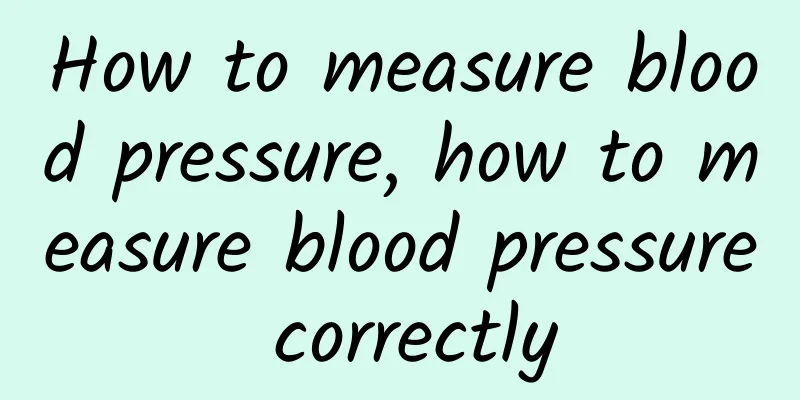How to measure blood pressure, how to measure blood pressure correctly

|
Blood pressure is an important indicator related to human health. When we go for a routine physical examination, measuring blood pressure is a must. However, although measuring blood pressure is very common, some people use incorrect methods when measuring blood pressure, resulting in inaccurate blood pressure. So, what is the correct way to measure blood pressure? 1. Methods of measuring blood pressure1: The person being measured should rest quietly for at least 5 minutes, refrain from smoking and drinking coffee within 30 minutes before measurement, and empty the bladder. 2: The person being measured should sit, preferably in a reclining chair; expose the right upper arm, with the elbow at the same level as the heart. If peripheral vascular disease is suspected, blood pressure should be measured in both arms during the first visit. Blood pressure can be measured in a supine or standing position under special circumstances; the elderly, diabetics, and those who often experience postural hypotension should measure blood pressure in an upright position. Orthostatic blood pressure measurement should be performed 2 minutes after changing from a supine position to a standing position. Regardless of the position of the person being measured, the sphygmomanometer should be placed at heart level. 3: Use a cuff of appropriate size. The air bag inside the cuff should cover at least 80% of the upper arm. Most people have an arm circumference of 25 to 35 cm, so it is appropriate to use an air bag cuff with a width of 13 to 15 cm and a length of 30 to 35 cm. Obese people or those with large arms should use a large cuff, and children should use a smaller cuff. 4: Tie the cuff tightly to the subject's upper arm, with the lower edge of the cuff 2.5 cm above the elbow. Place the probe of the stethoscope on the brachial artery at the elbow. 5: It is best to choose a mercury column blood pressure meter that meets the measurement standards for measurement. If a mechanical blood pressure gauge or an electronic blood pressure meter that meets international standards (BHS and AAMI) is used, it must be measured and calibrated at the same time as the mercury column blood pressure meter. 6: When measuring, inflate quickly, the pressure inside the balloon should reach the point where the radial artery pulsation disappears and then rises by 30 mmHg (4.0 kPa), then slowly deflate at a constant rate (2-6 mmHg/sec). The deflation rate is slower when the heart rate is slower. After obtaining the diastolic blood pressure reading, deflate quickly to zero. 7: Listen carefully to the Korotkoff sounds during deflation and observe the vertical height of the mercury column convex surface at the first and fifth phases of Korotkoff sounds. The systolic pressure reading is the first phase of Korotkoff sounds, and the diastolic pressure reading is the fifth phase of Korotkoff sounds (when the sound disappears). For children, pregnant women, severe anemia, aortic insufficiency or patients with Korotkoff sounds that do not disappear, the fourth phase of Korotkoff sounds (changed sound) is used as the diastolic pressure. 8: Blood pressure is measured in millimeters of mercury (mmHg). The conversion relationship between millimeters of mercury and kilopascals (kPa) is 1mmHg=0.133kPa. 9: Repeat the measurement 2 minutes apart and take the average of the 2 readings. If the difference between the systolic or diastolic blood pressure readings is >5 mmHg, measure again 2 minutes apart and take the average of the 3 readings. 2: A person's blood pressure changes during the day and at nightBlood pressure changes with time, usually higher during the day and lower at night. Affected by many factors such as emotions, changes in body position, noise, temperature, etc., if the conditions for measuring blood pressure are not stable enough, even several consecutive measurements of blood pressure can fluctuate greatly, even reaching more than 10 mmHg. |
<<: How to treat gallbladder cysts? How to treat gallbladder cysts?
>>: How to treat tonsil cysts, Chinese and Western medicine treatment methods
Recommend
What Chinese medicine is good for premature ejaculation?
Men always hope to last longer during sex. Someti...
Male chromosome examination items
Now people's living standards are gradually i...
What are the benefits of frequent foreskin rotation?
For male friends with foreskin that is too long, ...
Tips to help men get rid of their worries
Introduction: Modern people are under great press...
What are the dangers of frequent spermatorrhea?
As men grow older, their bodies mature and their ...
Sperm is yellow and looks like jelly with particles
In real life, male friends are more concerned abo...
What can men eat to increase immunity?
Immunity is something that everyone needs to have...
How to treat impotence?
As the pressure on men's shoulders increases,...
Does magnetic therapy underwear have any harm to sperm?
With the progress of society, more and more healt...
What would happen if I didn't have testicles?
Men's testicles can be said to be the most im...
Scientific treatment of premature ejaculation
Premature ejaculation is a male disease. This dis...
HPV test for men
HPV testing for men is a relatively rare practice...
Men's health knowledge
Health preservation is a common practice for midd...
Can a man's vasectomy be reversed?
A man's sterilization can be reversed. Steril...
Causes of spermatorrhea in adult men
Spermia is a common physiological activity. It is...









